
Copy
Q. Can I copy on an envelope or postcard?
A. Yes, you can also copy on an envelope and postcard.
For details on how to copy on envelopes, refer to Copying on Envelopes.
For details on how to copy on postcards, refer to Copying on Postcards.
Q. Can I copy on custom size paper?
A. Yes. You can make a copy by changing the paper settings of the tray loaded with custom size paper on the Paper Setting screen of copy mode. For details on how to copy on custom size paper, refer to Copying on Paper of a Custom Size.
In classic style, you can register the frequently used custom size paper in memory and recall it. For details on the operation procedure, refer to Copying on Paper of a Custom Size.
Q. How can I handle an original that contains too many pages to load in the ADF?
A. To copy an original containing a large number of pages, use the Separate Scan function.
The Separate Scan function enables scanning of an original in installments and handling of the resulting copy jobs as a single job.
For details on the operation procedure, refer to Scanning a number of originals in several batches ([Separate Scan]).

Q. The orientation of the image will not match that of the original.
A. Check the following settings on this machine:
(1) When [Automatic Image Rotation] is set to OFF, set it to ON.
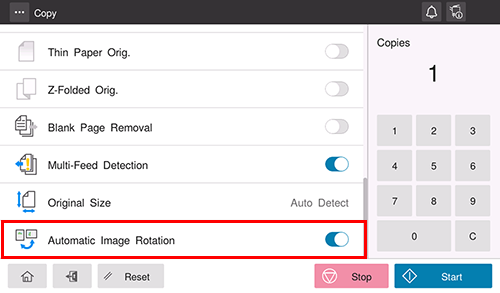
(2) When [Mixed Original] is enabled, set it to [OFF].
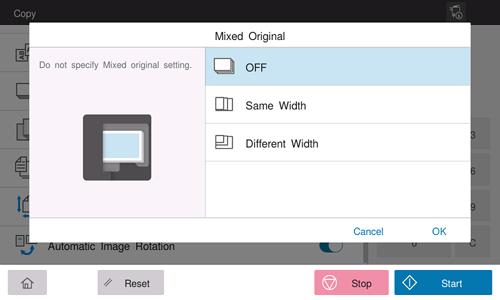
(3) When a zoom ratio for copying is manually specified, set [Zoom] to [100.0%].
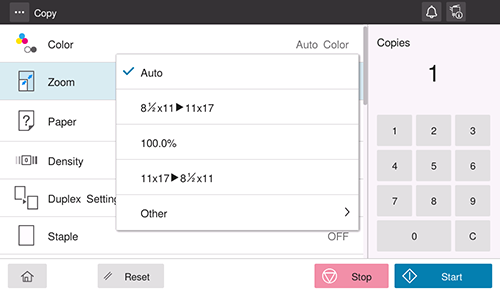
(4) Select [Utility] - [Administrator] - [Copier Settings] - [Basic Setting] - [Automatic Image Rotation], and select the setting that matches the paper orientation of the current original.
Q. Are there any paper-saving copying methods?
A. You can save paper by printing on both sides of the paper or printing more than one original page onto the same side of a single sheet of paper.
To copy on both sides of paper, select [1-Sided > 2-Sided] in [Original > Copy] of [Duplex Settings], and select the bind position for copying in [Output Binding Direction].
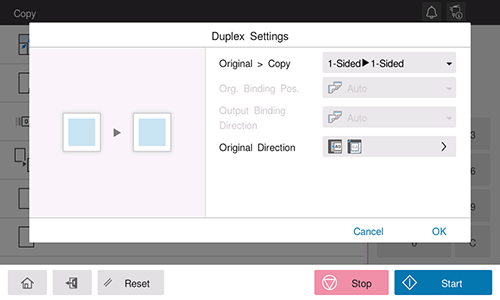
To copy multiple pages on the same side of one sheet, select the number of pages to copy on the same side of one sheet in [Combine].

Q. Can I register frequently used settings?
A. Yes. You can register a combination of copy option settings and easily recall them.
If you are using the basic style, register it to the Favorite Setting. For details on the operation procedure, refer to Registering Option Settings of Each Mode in Favorite.
If you are using the classic style, register it to the Copy program. For details on the operation procedure, refer to Recalling a Program for Copying.
Q. Can I check the finish before starting copying?
A. Yes, you can check the finish by outputting a proof copy.
You check either by referring to a preview image or by outputting just one copy for checking how it is actually finished. Using a proof copy helps preventing copy errors.
For details on the operation procedure, refer to Checking the Finishing Before Copying.
Q. Can I easily copy various cards such as an insurance card or driver license card?
A. Yes, you can copy the front and back sides of a card, side by side, on the same side of one sheet of paper.
For details on the operation procedure, refer to Copying a Card ([ID Card Shot]).

Q. What measures can I take against unauthorized copying?
A. To prevent unauthorized copying, there is a copy protection function that prints the hidden characters such as "FOR YOUR INFORMATION" and the date inconspicuously in the background.
To set copy protection, tap [Copy Protect] in [Application] of copy mode of classic style, and set the copy protection type.
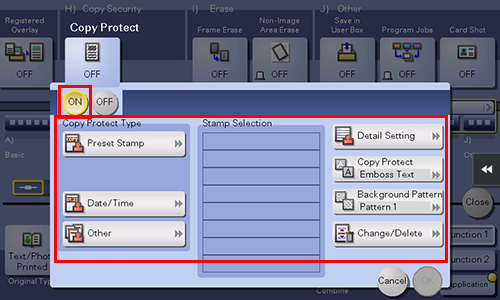
Setting | Description | |
|---|---|---|
[Preset Stamp] | Select a concealed security watermark from the 8 options. | |
[Date/Time] | Select a format for the date and time to be printed. The date/time as of scanning the original is stamped. | |
[Other] | [Job Number] | Select Yes to print the copy job number. |
[Serial Number] | Select Yes to print the serial number of this machine. | |
[Distribution Control Number] | Prints the distribution control number. Specify the distribution control number using a value between 1 and 99999999. | |
[Stamp Selection] | Part of the currently set concealed security watermarks can be listed. You can set up to eight watermarks. | |
[Detail Setting] | For concealed security watermarks, specify their size, density, and whether to lay them over or under the original text. | |
[Copy Protect] | Set the pattern and contrast for the concealed security watermarks to print. | |
[Bkgd. Pattern] | Select background patterns for copy protection from eight patterns. | |
[Change/Delete Position] | You can select an angle to show the text if no more than four used spaces are occupied by the concealed watermarks already set. To relocate concealed security watermarks, select the designed watermark, then tap [Up] or [Down]. To add a space between concealed security watermarks, select the designed watermark and tap [Insert Above] or [Insert Below]. To delete a concealed security watermark, select the watermark, then tap [Delete]. | |
- Also, copy guard and password copy functions are provided for higher security functions.
Copy Guard is a function that embeds a copy guard pattern in copy protection when printing.
Password Copy is a function that embeds a password for password copy in copy protection when printing. - To use the Copy Guard or Password Copy function, the appropriate option is required. For details on the required option, refer to "List of Functions with Options Required" in [User's Guide [About This Machine]].
Q. Can I copy with a text such as "FOR YOUR INFORMATION" or date added?
A. Yes, you can add a text such as "PLEASE REPLY" or "FOR YOUR INFORMATION", the date and page numbers to a copy job.
To add the date and time, tap [Date/Time] in [Application] of copy mode of classic style, and set [Date Format], [Time Format], and [Pages].
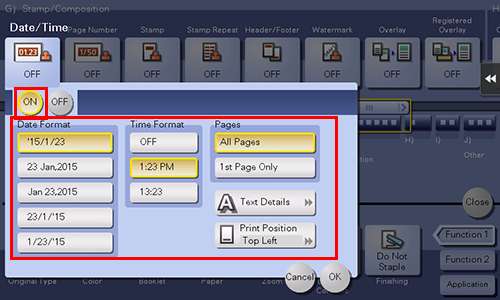
To add page numbers, tap [Page Number] in [Application] of copy mode of classic style, and set [Page Number Type] and [Starting Page Number]. If you have selected [Chapter Page] for [Page Number Type], specify the chapter number to start printing in [Starting Chapter Number]. When copying with covers, you can set the page numbers to be printed on the covers using [Insert Sheet Setting].

To add a stamp, tap [Stamp] in [Application] of copy mode of classic style, and set [Stamp Imprint] and [Pages].
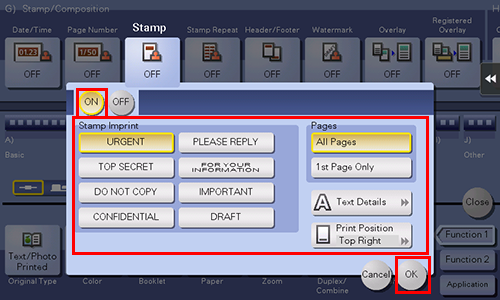
If the date/time, page number, and stamp are difficult to see with the default settings, tap [Text Details] on each of the [Date/Time], [Page Number], and [Stamp] setting screens; you can set the text size and font type. If the date and time, page numbers or stamp are over the text of the original, tap [Print Position] in each of the [Date/Time], [Page Number] and [Stamp] setting screens to set the printing positions.
- If necessary, you can register any stamp in addition to the stamps pre-registered in this machine. The registration procedure is explained using the data management utility in Web Connection. For details, refer to Managing the Stamp Data.
Q. Can I copy the original with its headers and punch holes erased?
A. Yes. Enable the frame erase function and the machine copies the original by erasing unwanted sections on the four sides of the original.
Tap [Frame Erase] in [Application] of copy mode of classic style. To erase all of the four sides of the original by the same width, set [Frame] to ON, and specify the width to be erased. To specify the width of the frame to be erased individually, set [Frame] to OFF, select a target side, then specify the width to be erased. When specifying the erase width individually, you can set to exclude a side from erasing by selecting the side and canceling the setting of [Erase] for that side.
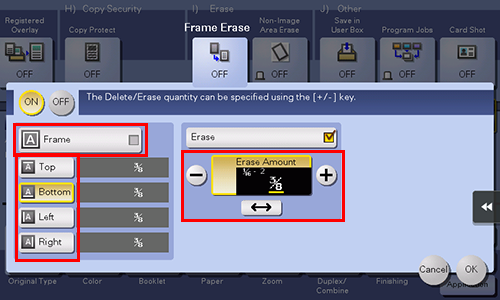
Q. Can I erase marks from fold lines when copying a book?
A. Yes, you can erase the marks by specifying the fold width. This setting is preferable for copying a book nicely.
If you are using classic style, tap [Book Original] in [Application] of copy mode, and select [Book Spread]. Set [Center Erase] to [ON], and enter the width of the fold lines to be erased.
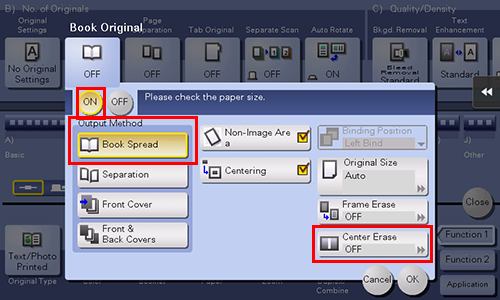
If you are using basic style, tap [Copy shadow rem.] in [Useful Apps] on the home screen.
Set [Fold] to ON, and specify the width of the fold lines to be erased.
For details on the operation procedure, refer to Erasing a Shadow for Copying ([Copy shadow rem.]).

Q. Is enlarged or reduced copying according to the paper size enabled?
A. Yes. You can automatically make a copy with the optimal zoom ratio to fit the paper size by simply selecting the paper size you want to apply to the loaded original.
Select [Paper] on the Copy screen, and select the tray loaded with the paper you want to enlarge or reduce.
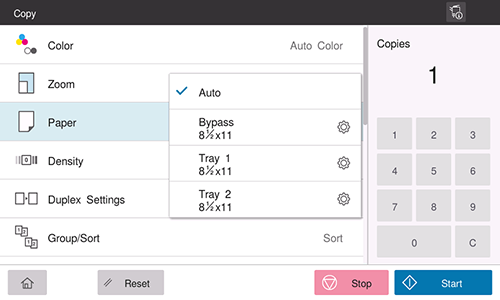
Q. Can I adjust the copying position to make filing easier?
A. Yes. You can shift and adjust the position of the entire copy image by setting the binding margin.
Tap [Page Margin] in [Application] of copy mode of classic style, and set the binding margin. To perform copying on both sides of the sheet, set [Margin Position] and [Original Direction] to ensure that the original is copied in the correct vertical orientation.
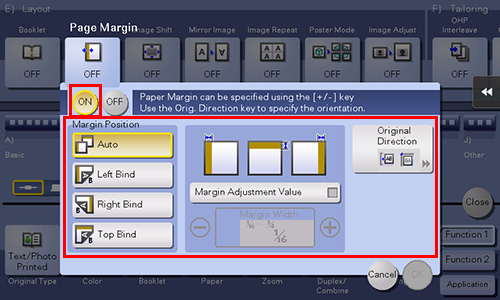
Setting | Description |
|---|---|
[Margin Position] | Select the position for creating the page margin for binding. When [Auto] is selected, the binding position is automatically set. |
[Margin Adjustment Value] | Enter the page margin. |
[Original Direction] | Select the original loading direction. |
- Take care as part of the image may be cut off depending on the margin setting.
Q. Can I perform copying with stapling or punching?
A. Yes, you can. Install relevant optional products on this machine to perform copying with stapling or punching.
Tap [Staple] or [Punch] on the Copy screen, and configure finishing settings.
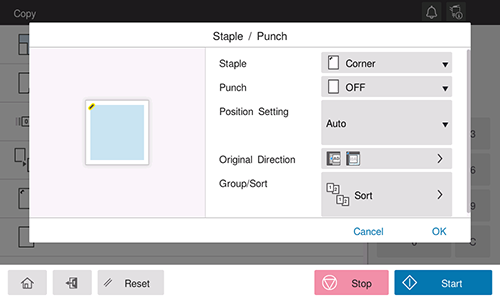
Setting | Description |
|---|---|
[Staple] | To staple sheets, select the stapling method. |
[Punch] | To punch sheets, select the required number of punch holes. |
[Position Setting] | Select a desired staple or hole-punch position. Setting to [Auto] automatically determines the stapling and punching positions based on the direction of the loaded original. |
[Original Direction] | Specify the orientation to load the original. |
- To use the staple or punch function, an option is required. For details on the required option, refer to "List of Functions with Options Required" in [User's Guide [About This Machine]].
- You can staple and punch copies at the same time.
Q. Can I use the offset function without the paper output option such as the Finisher?
A. Yes. Provided that the following requirements are met, outputs can be alternately ejected in transversal and longitudinal orientations set by set. This function is useful for making a large number of copies as it eliminates offsetting after copying.
Using paper of A4, B5, or 8-1/2 e 11
Loading paper of the same size and type in the transversal and longitudinal orientations
Setting [Auto] for paper
Tap [Group/Sort] on the Copy screen. Select [Group/Sort] - [Sort], and also select [Offset] - [ON].

Q. Can I use a magazine-like finish for a copy job?
A. Yes, you can copy and staple the sheets of paper in their center like a magazine or catalog. The original pages loaded are automatically arranged into an order appropriate for center binding, and the 2in1 function is activated to copy on both sides of the paper.
Tap [Booklet] in [Application] of copy mode of classic style, and set the print and bind operation.
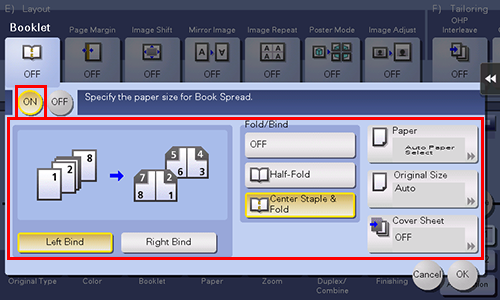
Setting | Description |
|---|---|
[Left Bind]/[Right Bind] | Select the binding position for the outputs. |
[Fold/Bind] | Select [Center Staple & Fold]. This function staples copies at two places along the center and folds the copies in half before feeding them out. |
[Paper] | Select the paper tray where paper for copying is loaded. |
[Original Size] | Select the size of the original to be copied. |
[Cover Sheet] | Use this option to copy the front and back covers onto separate paper when copying an original with a front or back cover. When copying an original without a front or back cover, you can use this function to have blank sheets of paper inserted as the front and back covers. |
- To use the Center Staple and Fold function, an option is required. For details on the required option, refer to "List of Functions with Options Required" in [User's Guide [About This Machine]].
Q. Can I add the company name or its logo to a copy job?
A. Yes. You can register the logos and favorite images in the storage of this machine to add such overlay images to copy outputs.

To register the logo or desired image in the storage of this machine, tap [Registered Overlay] in [Application] of copy mode of classic style, and tap [Register/Delete]. Tap [New], enter the overlay image name, then tap [OK]. Load the original containing the overlay image to be registered, change image settings as necessary, then tap [Start]. The original you have set is registered as an overlay image.
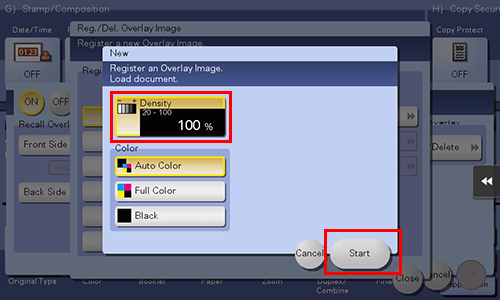
To overlay the registered image on the original image when copying, specify the surface on which the image is to be overlaid with [Registered Overlay], and tap the list icon ( ) to recall the overlaid image. Select the pages to print the image on and the original size, then tap [OK].
) to recall the overlaid image. Select the pages to print the image on and the original size, then tap [OK].
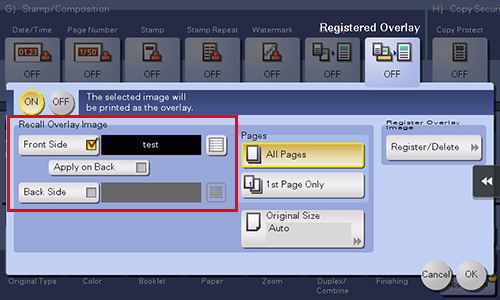
Q. Can I copy the right and left pages of two-page spreads like books or catalogs onto separate sheets?
A. Yes. Specify the scanning method to Separation to have spread pages copied one by one on separate pages.
Tap [Book Original] in [Application] of copy mode of classic style, and select [Separation]. When paper is set to [Auto], a message appears to notify that the paper tray will be switched. Tap [Yes].
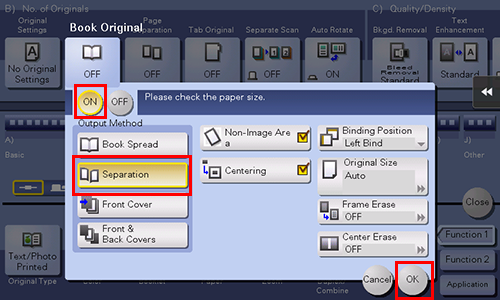
Q. Can I use a different paper type for the covers?
A. Yes. Use the cover sheet function to use a different paper type for copying the covers other than that used for the text body.
Tap [Cover Sheet] in [Application] of copy mode of classic style, and set the front and back covers.
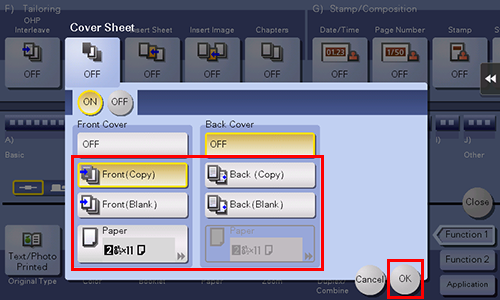
- Use paper of the same size for the body text and cover sheets, and ensure paper in the same orientation is used for both purposes.
Q. Can I interrupt a printing job to execute an urgent copy job for another original?
A. Yes. Tap [Interrupt ] in the side menu of classic style to pause printing once, then execute the urgent copy job first.
When the copy job is completed, a paused print job is restarted.
For details on the operation procedure, refer to Interrupt Copy.
Q. Can I arrange so that the margin does not come out in black when copying with the ADF opened?
A. Yes. Enable the Non-Image Area Erase Operation function, and the margin outside the original is copied in white. This function is also useful to reduce toner consumption as it erases everything other than the original.
Tap [Non-Image Area Erase] in [Application] of copy mode of classic style, and set to [ON]. The original size of 10 mm e 10 mm (3/8 inches e 3/8 inches) or more can be detected automatically. If the detection fails, a blank sheet of paper is output.

- The original image may be cut off at its top or end.
Q. Can I save image data after copying is completed?
A. Yes. You can print the copied image data and also save it to a User Box. The saved data can be printed when necessary.
Tap [Save in User Box] in [Application] of copy mode of classic style, and select the User Box for saving in [User Box]. To rename data to save in a User Box, rename it using [File Name]. To save data in a User Box and print the data at the same time, select the [Save & Print] check box.
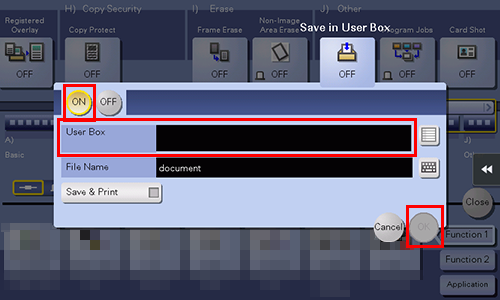
- Register the target User Box in advance. For details on the registration procedure, refer to Registering a User Box.
- Tap [New] when selecting a User Box for saving data, and you can save the data in a newly created User Box with only the User Box number specified.
Q. Is there a way to easily create a booklet?
A. When creating a booklet, use the booklet creation mode.
Follow the on-screen instructions to make settings; you can create a booklet without hesitation or mistakes.
Tap [Create a booklet] in [Useful Apps] of the home screen of basic style.
For details on the operation procedure, refer to Creating a Booklet ([Create a booklet]).



 in the upper-right of a page, it turns into
in the upper-right of a page, it turns into  and is registered as a bookmark.
and is registered as a bookmark.